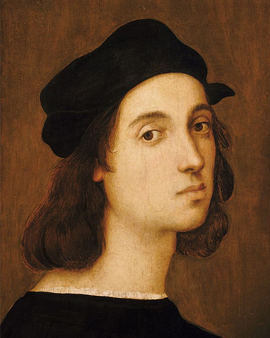Raffaello Sanzio (1483 - 1520) is considered one of the most important Italian painters and architects of the High Renaissance. Traditionally he is counted among the three great masters of this epoch, along with Leonardo da Vinci and Michelangelo. During his lifetime his fame was so high that he was widely known by his first name only. Born in Urbino, the artist lost his parents at a young age. When he was 8 years old his mother died. His father, the painter Giovanni Santi, died when Raphael was 11 years old. After he probably received his first artistic education from his father, Raphael was apprenticed to the painter Perugino. The talented boy soon managed to approach his master's style so perfectly that their works were difficult to distinguish. As early work contracts prove, Raphael was already called a master at the age of 17.
After his time in Perugia, Raphael went to Florence, where Da Vinci and Michelangelo had already achieved fame. Their masterpieces, as well as those of Masaccio and Fra Bartolommeo had a great influence on his further artistic development. After stays in Florence, Bologna and Urbino, Raphael finally went to Rome in 1508, following the call of Pope Julius II. There he soon rose in prestige and was allowed to portray various famous personalities of his time. Most of his work, however, consisted of decorating the Apostolic Palace with murals and various other commissions for the Church. His most important works "The Sistine Madonna", "Disputa del Sacramento" or "The School of Athens", in which he also immortalized himself, all date from the period between 1509 and 1517.
Raphael was long engaged to the niece of Cardinal Bernardo Dovizi. However, she died in 1520, so there was never a wedding. The second woman in Raphael's life was his favourite model and mistress Fornaria. He is said to have lived with her in Rome until his death. Raphael died already at the age of about 37 years. There is speculation about the exact circumstances of his death. While biographers such as Giorgio Vasari claimed that he died during a bloodletting which was prescribed for him because of a venereal disease, historians also consider a plague disease to be possible.
×





.jpg)
.jpg)
.jpg)
.jpg)
.jpg)
.jpg)
.jpg)
.jpg)
.jpg)
.jpg)
.jpg)
.jpg)
 - (MeisterDrucke-82088).jpg)
 - (MeisterDrucke-82088).jpg)
.jpg)
.jpg)
.jpg)
.jpg)
.jpg)
.jpg)
.jpg)
.jpg)
.jpg)
.jpg)
.jpg)
.jpg)
.jpg)
.jpg)
.jpg)
.jpg)
.jpg)
.jpg)
.jpg)
.jpg)
.jpg)
.jpg)
 - (MeisterDrucke-93585).jpg)
 - (MeisterDrucke-93585).jpg)
.jpg)
.jpg)
.jpg)
.jpg)
.jpg)
.jpg)
_c1518_(see_56299)_-_(MeisterDrucke-68138).jpg)
_c1518_(see_56299)_-_(MeisterDrucke-68138).jpg)
.jpg)
.jpg)
.jpg)
.jpg)
.jpg)
.jpg)
.jpg)
.jpg)
.jpg)
.jpg)
.jpg)
.jpg)
.jpg)
.jpg)
.jpg)
.jpg)
.jpg)
.jpg)
.jpg)
.jpg)
.jpg)
.jpg)
.jpg)
.jpg)
_(detail_of_56473)_-_(MeisterDrucke-37198).jpg)
_(detail_of_56473)_-_(MeisterDrucke-37198).jpg)
.jpg)
.jpg)
.jpg)
.jpg)
.jpg)
.jpg)
.jpg)
.jpg)
.jpg)
.jpg)
.jpg)
.jpg)
.jpg)
.jpg)
.jpg)
.jpg)
.jpg)
.jpg)
.jpg)
.jpg)
.jpg)
.jpg)
.jpg)
.jpg)
.jpg)
.jpg)
.jpg)
.jpg)
.jpg)
.jpg)
.jpg)
.jpg)
.jpg)
.jpg)
.jpg)
.jpg)
.jpg)
.jpg)
.jpg)
.jpg)
.jpg)
.jpg)
.jpg)
.jpg)
.jpg)
.jpg)
 (PRE RESTORATION) - (MeisterDrucke-203732).jpg)
 (PRE RESTORATION) - (MeisterDrucke-203732).jpg)
.jpg)
.jpg)
.jpg)
.jpg)
.jpg)
.jpg)
 c1512 - (MeisterDrucke-68694).jpg)
 c1512 - (MeisterDrucke-68694).jpg)
.jpg)
.jpg)
.jpg)
.jpg)
.jpg)
.jpg)
 - (MeisterDrucke-119091).jpg)
 - (MeisterDrucke-119091).jpg)
.jpg)
.jpg)
 (detail of 68213) - (MeisterDrucke-96596).jpg)
 (detail of 68213) - (MeisterDrucke-96596).jpg)
.jpg)
.jpg)
.jpg)
.jpg)
.jpg)
.jpg)
.jpg)
.jpg)
 of Urbino (1483-1520) from Gallery of Portraits published in 1833 - (MeisterDrucke-63936).jpg)
 of Urbino (1483-1520) from Gallery of Portraits published in 1833 - (MeisterDrucke-63936).jpg)
.jpg)
.jpg)
_detail_the_Virgin_Saint_Elizabeth_and_Child_c1518_-_(MeisterDrucke-131422).jpg)
_detail_the_Virgin_Saint_Elizabeth_and_Child_c1518_-_(MeisterDrucke-131422).jpg)
.jpg)
.jpg)
.jpg)
.jpg)
_-_(MeisterDrucke-390568).jpg)
_-_(MeisterDrucke-390568).jpg)
.jpg)
.jpg)
.jpg)
.jpg)
.jpg)
.jpg)
 c1513 - (MeisterDrucke-58280).jpg)
 c1513 - (MeisterDrucke-58280).jpg)
.jpg)
.jpg)
.jpg)
.jpg)
_-_(MeisterDrucke-143916).jpg)
_-_(MeisterDrucke-143916).jpg)
_-_(MeisterDrucke-636272).jpg)
_-_(MeisterDrucke-636272).jpg)
.jpg)
.jpg)
 1518 - (MeisterDrucke-62963).jpg)
 1518 - (MeisterDrucke-62963).jpg)
.jpg)
.jpg)
.jpg)
.jpg)
.jpg)
.jpg)
.jpg)
.jpg)
.jpg)
.jpg)
 1507 (see 205588 205589) - (MeisterDrucke-189785).jpg)
 1507 (see 205588 205589) - (MeisterDrucke-189785).jpg)
 - (MeisterDrucke-97329).jpg)
 - (MeisterDrucke-97329).jpg)
.jpg)
.jpg)
.jpg)
.jpg)
.jpg)
.jpg)






